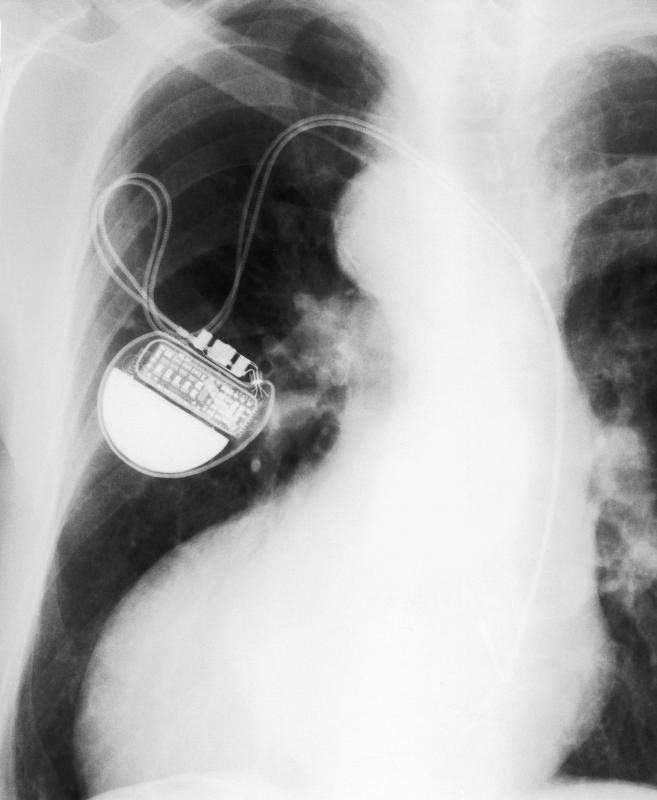At WiseGEEK, we're committed to delivering accurate, trustworthy information. Our expert-authored content is rigorously fact-checked and sourced from credible authorities. Discover how we uphold the highest standards in providing you with reliable knowledge.
What Are the Uses for a DDDR Pacemaker?
A DDDR pacemaker takes over some of the heart's natural pacemaker functions when this organ is not beating correctly. Sometimes called a dual chamber rate adaptive pacemaker, it can be programmed by a cardiologist specifically for the patient, to apply just the pacing needed to make up for the heart's insufficiency, and it can work in both the right and left ventricles. A DDDR pacemaker also can work in the right and left atriums of the heart, which are the reservoirs of blood for the ventricles. It is said to be rate adaptive as it can adjust and regulate pacing automatically. This is one of the most commonly used types of pacemakers, as it can address the widest range of heart pacing issues.
The letters DDDR identify the type of pacemaker it is, according to what are called NBG codes or Generic Codes categorizations that have been set up by two medical pacing and electrophysiology groups in North America and Britain. These letters correspond to the functions or uses of a DDDR pacemaker. The letters mean Dual chamber-paced, Dual chamber-sensed, Dual response, and Rate modulated.

Since this pacemaker is designated as dual chambered, it has wires to both an atrium and a ventricle, pacing each as the heart's natural pacemaker would. Placed between the fat of the chest area and the underlying muscles and bones, it is usually powered by a lithium battery. There, a sensing amplifier receives input from electrodes of what pacing the heart is doing on its own, and then modifies by means of its output circuitry any correcting pulses needed through those same electrodes. Once corrective pulses have corrected atrial arrhythmias, for instance, the pacemaker returns to its listening, tracking, and sensing activity once again.

These functions of the DDDR pacemaker are programmed into the device by the cardiologist by means of what are called automatic mode-switching algorithms for both the atria and the ventricles. The cardiologist can choose which algorithms to use according to the individual patient's heart conditions. Then, beat after beat, the heart is regulated as it normally would have been, if its own natural pacemaking ability had not been compromised. Pacemakers can be recalibrated remotely on an outpatient visit by the cardiologist after implantation, when or if conditions change. DDDR pacemakers also keep a record of all anomalies, which can be extracted by the cardiologist during an outpatient visit thorough a process called pacemaker interrogation.
AS FEATURED ON:
AS FEATURED ON:














Discussion Comments
@browncoat - The thing is, I think sometimes there's not going to be a reason that anyone can find. Maybe it was a virus, or maybe it was just general wear and tear. Either of those could do the damage without leaving obvious signs of why the damage occurred.
Pacemaker surgery is quite common actually. Humans have never lived so long, and our bodies aren't quite used to it, so they often need a bit of help in the later years.
Generally a person with a pacemaker can do anything they want though. They've even managed to make them now so they can go through MRI scanners without any problems.
@irontoenail - At least your mother has the option of having a pacemaker installed. Imagine if she was living in an age where all they could do was tell her to try not to exert herself and hope for the best? Or even worse, a time where they wouldn't have known what was happening to her at all.
A pacemaker is relatively safe compared with other kinds of surgery and installations. It lasts a long time, and about the only thing she'll have to worry about is getting it through airport security.
And I'm sure the doctors working on her case are still trying to figure out what went wrong with her heart. They might still come up with something.
My mother has recently been told she's going to have to put in a pacemaker. At first the doctors said she might be able to hold off for a year or so, but now they want to put one in pretty much right away.
The thing that scares me a little about it, is that they know she needs a pacemaker, and they know what's wrong with her heart, but they don't seem to know why her heart suddenly failed like that.
I know things can go wrong and they do all the time, but I'd like to know why. If it's something that could affect her again somehow, they should know about it. If it's a genetic fault, I'd like to know about it, if only so I can make sure to keep an eye on my own heart!
I suppose even now medicine is often a case of "the best guess wins" but it is really frustrating when those guesses are attached to a human life.
Post your comments